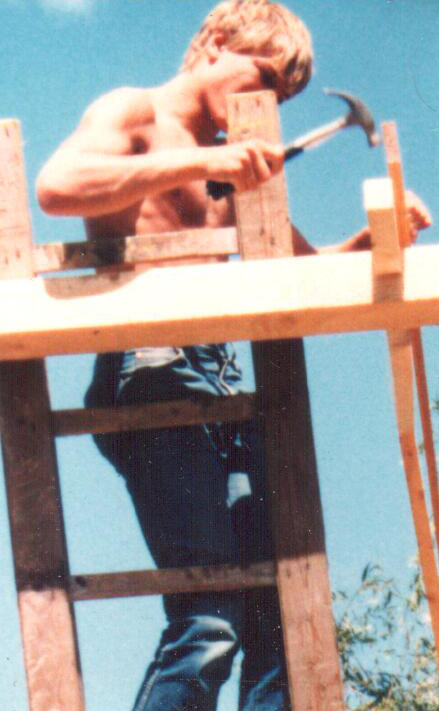
was a carpenter.
*The Swedish word for this is morfar, a short form of ”mothers-father”, which in my childhood dialect is pronounced måffarr. Even if perhaps slightly confusing in an English text, I intend to use this term in honor of how I remember him.
His apprenticeship was alternated with military service since WWII was going on simultaneously. He was riding a bicycle to the different assignments with his toolbox on the carrier.
When I was a toddler, he started his own construction firm after having been employed a number of years as a supervisor at one of the larger local construction companies.

As far back as I can remember, I spent a large amount of my time riding along in måffarr’s small truck between the different building sites, or accompanying måffarr when he was either working himself or instructing his crew.
In that way I got to watch and participate in most things related to building, even if carpentry and woodworking was the topic closest to my heart, as well as to måffarr’s.

As I grew older, I got to assist more and more. As a teenager I worked with måffarr on most weekends and hollidays, and this kept going on until I entered military service and eventually moved to Halmstad for university studies.
One could perhaps dare to say that I became an almost fully trained carpenter in this process, at least with regards to the practical aspects. The theoretical knowlede however is limited to what I have seen and done, but I lack the more generic parts of the subject. And building methods have developed since then.
Nevertheless, I have from a very early age been trained in the use of various tools and I flatter myself by believing that I am quite proficient in these matters even if I have no formal training.
I became a mechanical engineer instead, which surprised most people who had anticipated that I would end up in the construction business.
A huge advantage of having started in the fashion of old-school apprenticeship is that I have grown into the craftmanship by starting out doing loads of simple, sometimes very booring, chores and then successively been given the responsibility for more demanding and complex work.
Having been ”forced” to start of with doing what in Swedish is called ”the shitty-work”, for example cutting countles of boards using a hand saw, has implemented the skills directly ”into your hands”.
You shouldn’t underestimate visual input either. I quite often get surprised when undertaking some carpentry or masonry work that I have actually never done before myself, but find out that my hands are quite cabable of doing it anyway. It all comes naturally without having to think about it.
The only explanation I can come up with is that as a child, I observed with great interest when måffarr or some of his crew member performed this particular activity, and this visualisation has been stored somewhere in my brain and somehow connected into my motor skills memory.
I remember with great pride when måffarr occaisonally found it necessary to explain to his crew that this boy has the hands for it to justify to them why I could be made responsible for a particular assignment even if they didn’t think I was old enough.
An interesting aspect that I have come to understand only in retrospect is måffarr’s educational philosophy. He thought it was better and safer to teach even potentially dangerous things at an early age. Then you learn it correctly from the beginning, and the risk that you should start experimenting on your own before you have the sufficient knowledge or skill decreases. My grandmother on the other hand had a more protective approach and would not have aggreed. If only she had known…
Don’t let him get into something dangerous she always said before we were leaving.
No, no, of course not måffar answered, and when we came out he taught me how to use the electric jigsaw, I was about ten by that time, or something else my grandmother would definitely not have approved of.
But his methods worked perfectly, until this day I have never hurt myself on any machinery or electric tool.
Hand tools are a completely different ballgame though, since you have to power them manually you inevitably slip now and then. But if you use them sensibly this risk decreases significantly, and a few mistakes in this respect is part of the training according to måffarr, it is the only way of learning.
The only time måffarr raised his voice to me was four floors up at a building site. The crew prepared for roofing and I was standing at the high end of a ladder which in turn was placed on the top floor of the scafolding. I was merely a spectator since I was too young to be trusted with anyting else and to small to be of any use.
But when I saw the rest of the crew balancing around on the beams, lifelines were not in common use back then, it looked fun to me so I started a balancing act of my own along the crest of the brick wall. Quite quickly however, måffarr made me understand that this was not a good idea at all, so I returned to the ladder, quite lop-eared. That’s all there was to it.
Måffar obviously had his eyes on me a lot more than I understood at the time, even if he didn’t make a fuzz about it. Continous nagging was not his style, but when he said something he was serious about it.
You cannot demonstrate your ability to act responsibly if you don’t have the freedom to act erroneously was probably also one of his axioms.
I used to get left-over lumber and other materials to build things from. As I grew older it happened that måffarr bought new stuff from the lumber yard specifically for some of my projects if I needed something in particular.
Or took the oportunity to teach me something. Back in his days as an apprentice, the assortment at the lumber yard was not as elaborate as nowadays, often you had to create the pieces and shapes you needed by yourself, using simple hand tools like a saw, a plane or a chisel.
To wrap it up, I am in no way a professional when it comes to build things. But if you ask me I would humbly say that I am handier than the average guy. My experience is however mostly based on building carpentry, not on cabinetwork.
But it shouldn’t be entirely impossible to put together a kayak or two. What is definitely outside of my comfort zone is the epoxy and fibreglass work. But that should be feasible nevertheless, if I follow a relevant instruction and think it through before I start.
The first buliding project will be considered a learning project intended to find out how I should have done.
I call this a day, at least for now.


Lämna ett svar